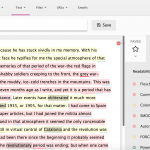I read my first interactive book when I was 3. It was called Pat the Bunny, and it required the reader to touch, scratch, and otherwise interact with the pages. Like most people, I outgrew these sort of books by the time I was 6. But last month I rediscovered interactive books. Their adult form is called ergodic literature.
What is Ergodic Literature?
According to Wikipedia, ergodic literature is a book where “nontrivial effort is required to allow the reader to traverse the text.” In other words, a book where the words go up, down, sideways, and backwards. It sometimes requires moving back and forth across pages, or reading words written within smaller boxes on the page.

The ergodic book I was reading was House of Leaves. The book is a film critique within a book within a book. I’m still not sure whether I enjoyed it, whether I would recommend it, whether or not it’s a “good” story or a “good” book. It’s not the most enjoyable read – it does require nontrivial effort – but it captured my attention. What is most fascinating to me about ergodic (and interactive) literature though, is the emphasis on layout. And as a content strategist, the possible impact of ergodic literature on intelligent content.
Can Ergodic Content be Intelligent?
Intelligent content is content that is structurally rich and semantically categorized. In other words, content that is designed in “chunks”. As a result, we can use and reuse it in a variety of contexts. When we create intelligent content, we’re setting ourselves up to publish that content once, but reuse it in various layouts and setups across the web.
But what makes House of Leaves both confusing and alluring is the layout. The author/designed could have created a footnote instead of a “curlique” of content. But then it wouldn’t be ergodic. It is ergodic because the curlicue, circling the page and other text. You could create a “curlique” intelligent content type. But that type only makes sense if it’s displayed on that specific page.
Does Ergodic Literature Break Intelligent Content?
Ergodic literature doesn’t break the concept of intelligent content. In fact, it proves the value of it. Intelligent content makes content easier to traverse. Ergodic content is intentionally difficult, because of its use of layout and space.
Content strategists know that layout and space impact every story. That is why we create intelligent content. Intelligent content makes it easy to share snips of stories in contextually appropriate mediums. That gives designers freedom to craft the layout and space.
Ergodic literature is fascinating specifically because it is not intelligent. It’s the Savage in our Brave New World, the purposefully beautiful chaos in the midst of an organized future. It’s a holistic art form. Neither efficient nor usable. We can’t break it into pieces or recreate it.
And I’m still not sure whether to recommend House of Leaves.


